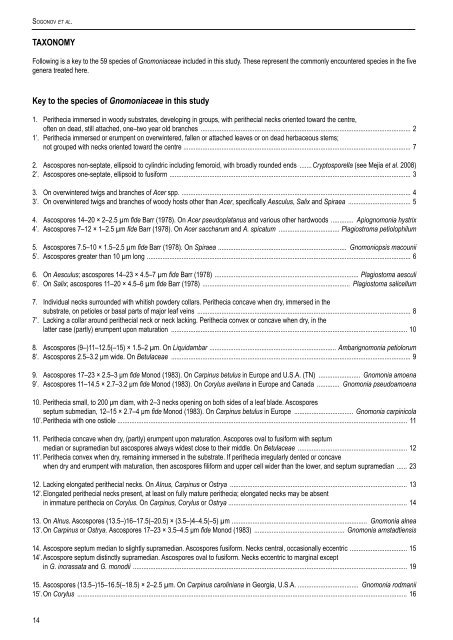Leaf-inhabiting genera of the Gnomoniaceae, Diaporthales - CBS
Leaf-inhabiting genera of the Gnomoniaceae, Diaporthales - CBS
Leaf-inhabiting genera of the Gnomoniaceae, Diaporthales - CBS
You also want an ePaper? Increase the reach of your titles
YUMPU automatically turns print PDFs into web optimized ePapers that Google loves.
So g o n o v e t a l.<br />
TAXONOMY<br />
Following is a key to <strong>the</strong> 59 species <strong>of</strong> <strong>Gnomoniaceae</strong> included in this study. These represent <strong>the</strong> commonly encountered species in <strong>the</strong> five<br />
<strong>genera</strong> treated here.<br />
Key to <strong>the</strong> species <strong>of</strong> <strong>Gnomoniaceae</strong> in this study<br />
1. Peri<strong>the</strong>cia immersed in woody substrates, developing in groups, with peri<strong>the</strong>cial necks oriented toward <strong>the</strong> centre,<br />
<strong>of</strong>ten on dead, still attached, one–two year old branches .......................................................................................................................... 2<br />
1’. Peri<strong>the</strong>cia immersed or erumpent on overwintered, fallen or attached leaves or on dead herbaceous stems;<br />
not grouped with necks oriented toward <strong>the</strong> centre ................................................................................................................................... 7<br />
2. Ascospores non-septate, ellipsoid to cylindric including femoroid, with broadly rounded ends ........ Cryptosporella (see Mejia et al. 2008)<br />
2’. Ascospores one-septate, ellipsoid to fusiform ........................................................................................................................................... 3<br />
3. On overwintered twigs and branches <strong>of</strong> Acer spp. .................................................................................................................................... 4<br />
3’. On overwintered twigs and branches <strong>of</strong> woody hosts o<strong>the</strong>r than Acer, specifically Aesculus, Salix and Spiraea ..................................... 5<br />
4. Ascospores 14–20 × 2–2.5 µm fide Barr (1978). On Acer pseudoplatanus and various o<strong>the</strong>r hardwoods .............. Apiognomonia hystrix<br />
4’. Ascospores 7–12 × 1–2.5 µm fide Barr (1978). On Acer saccharum and A. spicatum .................................... Plagiostroma petiolophilum<br />
5. Ascospores 7.5–10 × 1.5–2.5 µm fide Barr (1978). On Spiraea .......................................................................... Gnomoniopsis macounii<br />
5’. Ascospores greater than 10 µm long ........................................................................................................................................................ 6<br />
6. On Aesculus; ascospores 14–23 × 4.5–7 µm fide Barr (1978) ................................................................................... Plagiostoma aesculi<br />
6’. On Salix; ascospores 11–20 × 4.5–6 µm fide Barr (1978) ...................................................................................... Plagiostoma salicellum<br />
7. Individual necks surrounded with whitish powdery collars. Peri<strong>the</strong>cia concave when dry, immersed in <strong>the</strong><br />
substrate, on petioles or basal parts <strong>of</strong> major leaf veins ............................................................................................................................ 8<br />
7’. Lacking a collar around peri<strong>the</strong>cial neck or neck lacking. Peri<strong>the</strong>cia convex or concave when dry, in <strong>the</strong><br />
latter case (partly) erumpent upon maturation ......................................................................................................................................... 10<br />
8. Ascospores (9–)11–12.5(–15) × 1.5–2 µm. On Liquidambar ......................................................................... Ambarignomonia petiolorum<br />
8’. Ascospores 2.5–3.2 μm wide. On Betulaceae ........................................................................................................................................... 9<br />
9. Ascospores 17–23 × 2.5–3 μm fide Monod (1983). On Carpinus betulus in Europe and U.S.A. (TN) ......................... Gnomonia amoena<br />
9’. Ascospores 11–14.5 × 2.7–3.2 μm fide Monod (1983). On Corylus avellana in Europe and Canada .............. Gnomonia pseudoamoena<br />
10. Peri<strong>the</strong>cia small, to 200 μm diam, with 2–3 necks opening on both sides <strong>of</strong> a leaf blade. Ascospores<br />
septum submedian, 12–15 × 2.7–4 μm fide Monod (1983). On Carpinus betulus in Europe ................................... Gnomonia carpinicola<br />
10’. Peri<strong>the</strong>cia with one ostiole ....................................................................................................................................................................... 11<br />
11. Peri<strong>the</strong>cia concave when dry, (partly) erumpent upon maturation. Ascopores oval to fusiform with septum<br />
median or supramedian but ascospores always widest close to <strong>the</strong>ir middle. On Betulaceae ................................................................ 12<br />
11’. Peri<strong>the</strong>cia convex when dry, remaining immersed in <strong>the</strong> substrate. If peri<strong>the</strong>cia irregularly dented or concave<br />
when dry and erumpent with maturation, <strong>the</strong>n ascospores filiform and upper cell wider than <strong>the</strong> lower, and septum supramedian ....... 23<br />
12. Lacking elongated peri<strong>the</strong>cial necks. On Alnus, Carpinus or Ostrya ....................................................................................................... 13<br />
12’. Elongated peri<strong>the</strong>cial necks present, at least on fully mature peri<strong>the</strong>cia; elongated necks may be absent<br />
in immature peri<strong>the</strong>cia on Corylus. On Carpinus, Corylus or Ostrya ....................................................................................................... 14<br />
13. On Alnus. Ascospores (13.5–)16–17.5(–20.5) × (3.5–)4–4.5(–5) µm .............................................................................. Gnomonia alnea<br />
13’. On Carpinus or Ostrya. Ascospores 17–23 × 3.5–4.5 μm fide Monod (1983) ..................................................... Gnomonia arnstadtiensis<br />
14. Ascospore septum median to slightly supramedian. Ascospores fusiform. Necks central, occasionally eccentric ................................. 15<br />
14’. Ascospore septum distinctly supramedian. Ascospores oval to fusiform. Necks eccentric to marginal except<br />
in G. incrassata and G. monodii ............................................................................................................................................................... 19<br />
15. Ascospores (13.5–)15–16.5(–18.5) × 2–2.5 µm. On Carpinus caroliniana in Georgia, U.S.A. ................................... Gnomonia rodmanii<br />
15’. On Corylus ............................................................................................................................................................................................... 16<br />
14

















